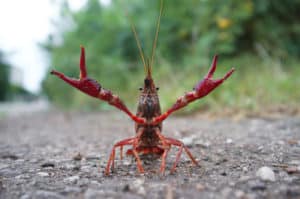I was catering a crawfish boil pool party, when one of the guests came up to me and asked, “Hey, what happens if you don’t purge crawfish?” I replied that the crawfish might end up tasting gritty and not as delicious as they could be.
I explained that purging crawfish involves soaking and rinsing them in clean water to remove any dirt or debris that may be in their digestive tracts.
I told the guest that if you skip this step, you might end up with crawfish that have not been properly cleaned and may have a sandy texture when you eat them.
So, it’s always a good idea to take the time to purge your crawfish before cooking them to ensure the best possible taste and texture.
If you’re new to boiling crawfish or simply looking to refine your technique, I highly recommend checking out my guide on how to boil crawfish.
It’s important to get the purging process right, and my guide offers step-by-step instructions to ensure that your crawfish boil is a success.
One of the most important steps in preparing crawfish is purging, which involves cleaning out the crawfish’s digestive tract to remove any sand or grit that may be present.
But what happens if you don’t purge crawfish? In this post, we will explore the consequences of skipping this crucial step and provide tips on how to properly prepare crawfish for a delicious meal.

What Happens If You Don’t Purge Crawfish
Let’s explore what happens if you don’t purge your crawfish?
Gritty Texture
The most immediate consequence of not purging crawfish is that they will have a gritty texture when you eat them.
This is because the sand and grit in their digestive tracts will not be removed, resulting in a crunchy, unpleasant texture in your mouth.
Unpleasant Taste
In addition to the gritty texture, crawfish that have not been purged may also have an unpleasant taste.
The sand and dirt in their digestive tracts can give the crawfish a muddy flavor, which is not desirable when preparing them for consumption.
Reduced Shelf Life
Crawfish that have not been purged may also have a reduced shelf life. The sand and dirt in their digestive tracts can contribute to bacterial growth, which can spoil the crawfish more quickly.
This means that they may not last as long in the refrigerator, which can be a problem if you’re planning to use them for a meal later in the week.
Health Risks
Finally, not purging crawfish can also pose health risks. The sand and dirt in their digestive tracts may contain harmful bacteria, such as E. coli or Salmonella, which can cause food poisoning if ingested.

The Importance of Purging Crawfish
Let’s talk about why it’s so important to purge Crawfish. Crawfish live in freshwater environments, where they can easily pick up sand, dirt, and other debris in their digestive tracts.
If this debris is not removed, it can make the crawfish gritty and unpleasant to eat.
Purging crawfish is a simple process that involves soaking them and rinsing them in clean water for several hours to allow them to expel any sand or grit in their digestive tracts as well as the dirt and mud on the exterior of the crawfish.
The process can take anywhere from 30 minutes to several hours, depending on the size and number of crawfish you are purging.
Check out my latest post where I explore the age-old question of whether you should purge crawfish or not, and learn how to ensure the best taste and texture.

How to Properly Purge Crawfish
Now that we understand the potential consequences of not purging crawfish, let’s discuss how to properly purge them to avoid these issues.
1.) Fill an ice chest or wash tub with water and dump the crawfish into the container.
2.) With a water hose, fill the container with water until the crawfish are completely covered.
3.) Stir the crawfish around with a paddle and pick out any dead crawfish that float to the top of the container during the purging process.
4.) Dump out the water and repeat the process until the water turns clear, which may take several cycles.
5.) Once the water is clear, set aside the crawfish in a shady spot until you’re ready to boil them.
6.) When you’re ready to boil the crawfish, drain the water from the container and place the crawfish in a pot of boiling water.
It’s worth noting that the purging process is crucial to removing any musty or earthy flavor associated with crawfish, so skipping this step can result in some of the nastiest tasting crawfish.
While everyone in the crawfish community has a different purging method, using water and picking out the dead crawfish is a labor-intensive but effective way to ensure the best taste and texture.
If you’re looking for a way to make the crawfish purging process easier, you should check out the Cowboy’s Crawfish Washer – it’s a game changer!

Do you use salt to purge crawfish?
There’s a common myth in the world of crawfish that involves using salt to purge them. Some people claim that adding salt to the water will make the crawfish vomit and help with the purging process.
However, this is simply not true. Salt does not work any better than normal freshwater for purging crawfish.
In fact, the only effect of salting crawfish is inducing pain, which causes them to squirm around until fresh water is added.
Additionally, salting crawfish before boiling them can actually be detrimental because it may kill a significant portion of the crawfish, resulting in wasted money and effort.

Conclusion
Purging crawfish is a crucial step in preparing them for consumption. Skipping this step can result in gritty, unpleasant crawfish with an unpleasant taste, reduced shelf life, and even health risks.
By following the proper purging techniques and tips outlined in this post, you can ensure that your crawfish are clean, fresh, and delicious.
So don’t skip the purging process – take the time to properly prepare your crawfish for a truly enjoyable meal.

